Beef Bulgogi, aka Korean bbq beef, is one of my favorite bbq dishes. It consists of thinly sliced marinated beef grilled, or seared, until charred and caramelized. It’s sweet, savory, and slightly spicy.
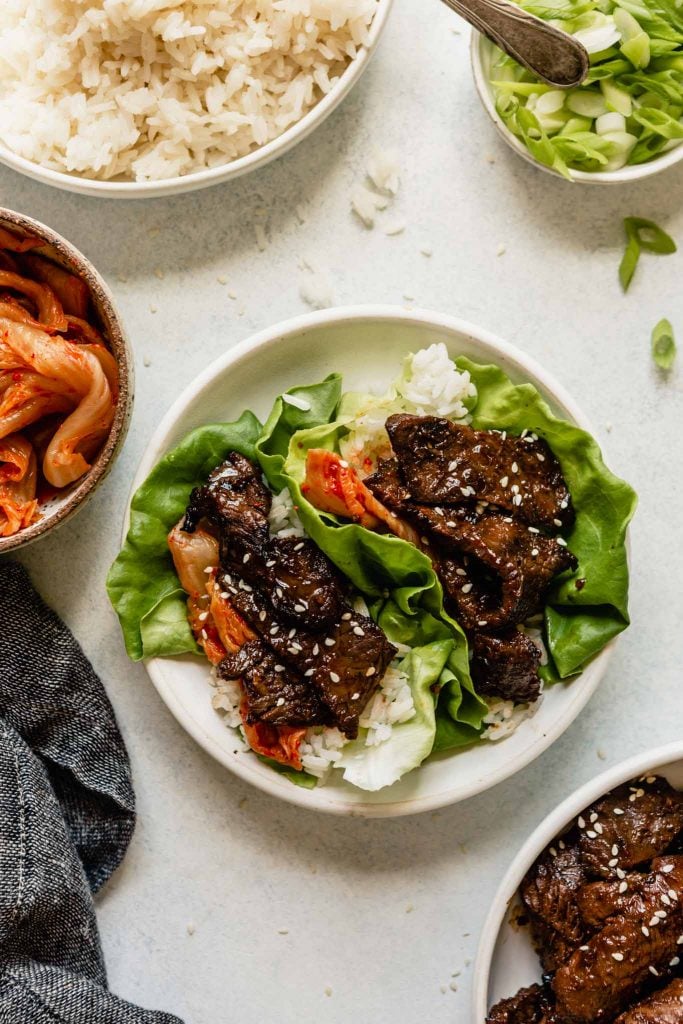
There’s just something about Korean food that I can’t get enough of. I find Korean cuisine to be incredibly savory and satisfying. Many Korean dishes are sweet, spicy, and full of umami. And bulgogi is the quintessential example of a reallllly good Korean meat dish.
What is bulgogi?
Bulgogi, which is Korean bbq, translates as “fire meat.” Generally, bulgogi is made with tender cuts of beef, but it can also be made with pork and chicken. The process of making bulgogi varies widely from region to region, and this recipe follows the general process and idea, but does have some differences that keeps this from being super traditional.
Beef bulgogi features tender meat sliced very thin and marinated in a sweet and savory mixture. The beef is then cooked quickly over high heat and served with rice and perilla leaves. For my version, which is less traditional, I serve it in bibb lettuce leaves with rice, kimchi, and green onions. If you can find perilla leaves, I encourage you to give those a try!
Learn more about the history and evolution of Bulgogi and Korean cuisine.
[adthrive-in-post-video-player video-id=”zAc6wFSt” upload-date=”2021-03-26T15:27:59.000Z” name=”Beef Bulgogi (Korean BBQ)” description=”Beef Bulgogi, aka Korean bbq beef, consists of thinly sliced marinated beef grilled, or seared, until charred and caramelized. It’s sweet, savory, and slightly spicy.” player-type=”collapse” override-embed=”false”]Bulgogi marinade
The marinade for bulgogi varies, but traditionally it consists of black pepper, garlic, onion, ginger, sesame oil, sesame seeds, soy sauce, sugar and rice wine (mirin). Oftentimes Asian pear or pear juice is added as well—it contains a tenderizing enzyme.
For my version of bulgogi I skip the pear but you could certainly add ½ cup of grated Asian pear to the marinade. I also add gochujang, which is not traditional but it’s Korean and I find it adds a nice savoriness.
If you don’t have gochujang you can use ½ a teaspoon or so of red pepper flakes and a bit more honey. Lastly, I use honey instead of brown sugar which makes the meat slightly less sweet, but in my opinion I don’t miss that.
What you’ll need:
- low-sodium soy sauce (or tamari if gluten-free)
- grated white or yellow onion
- honey
- gochujang, or gluten-free gochujang if needed
- garlic
- ginger
- mirin or rice wine
- toasted sesame oil
- cracked black pepper
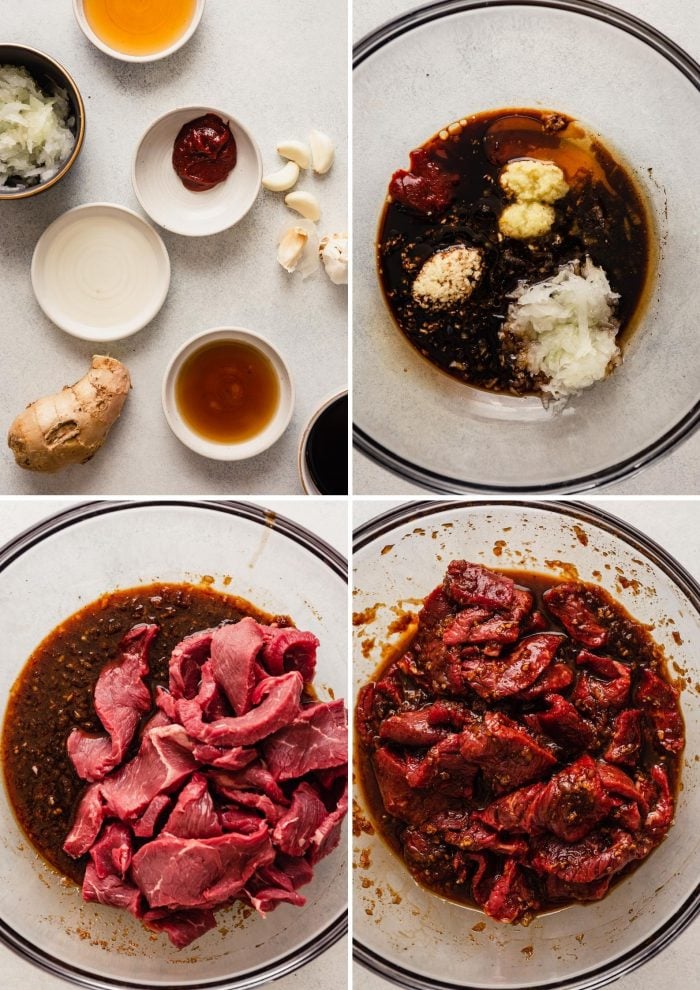
What kind of beef to use for bulgogi
For beef bulgogi I prefer to use boneless ribeye or top sirloin, though you can certainly use any tender cut of beef. Some recipes use flank, and although it takes well to marinating, it isn’t the most tender cut of meat. If you do use flank steak, be sure to cut against the grain.
The prep for this recipe is really quick, and although it does require some marinating time, you can control the length of it.
The beef doesn’t need a long time to marinate, but if you’ve got some extra time let the meat marinate for 4 hours or up to overnight. Crunched for time? Marinate it for just 2 hours. I find the best flavor and texture comes from marinating the meat for at least 3–4 hours, but you do what works best for you!
Can I use a different kind of meat?
Sure! Check out this recipe for chicken bulgogi if you’re looking for a lighter, white meat option.
You can also make this bulgogi with pork if you prefer. The consensus on what type of cut is unclear, I’ve seen recipes use everything from pork butt to boneless, skinless pork shoulder, pork belly, and pork tenderloin. So use what you like or have on hand!
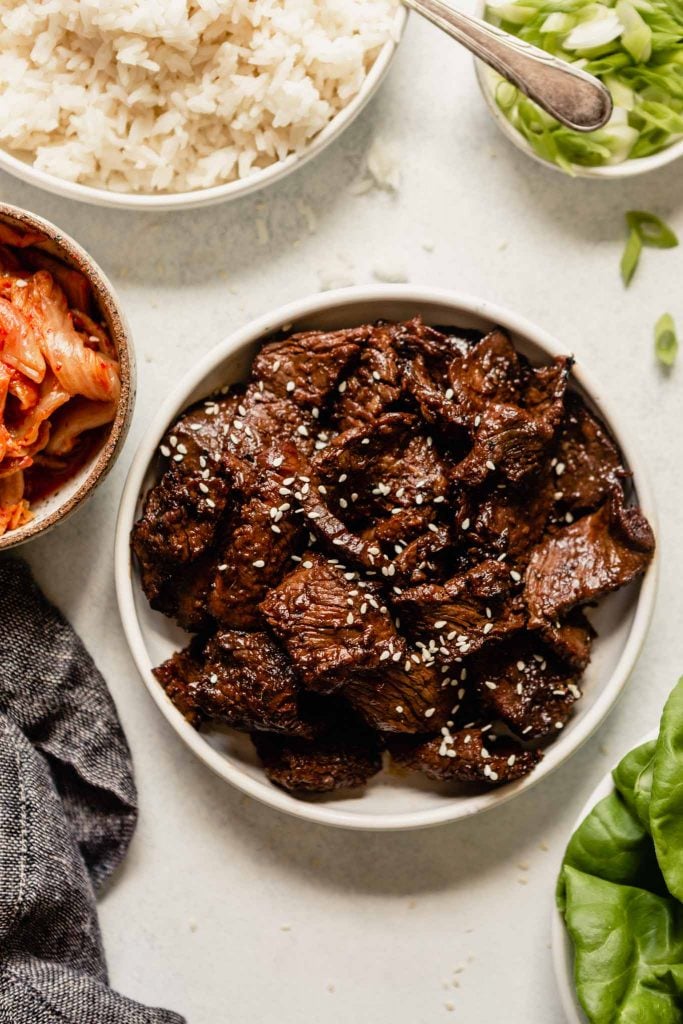
Tenderizing the meat
There are three main characteristics of bulgogoi: the flavorful marinade, the thinly sliced meat, and the high heat it’s cooked over.
The marinade is essential. Not only does it adds TONS of flavor, but it also tenderizes the meat. Shredded Asian pear or pear juice is a common ingredient in bulgogi marinades, and for good reason. Pears contain a tenderizing enzyme. As does pineapple, kiwi, and papaya.
So you may be wondering why I left out the pear if it’s traditional. Before I give my reasoning, I first want to say that you should absolutely add it if you want to keep this traditional! I would recommend adding about ½ cup of shredded pear or ¼ cup pear (or pineapple) juice to the marinade.
The reason I left pear out of the marinade is because frankly, if you use a tender cut of beef you don’t really need it—in my opinion. Again, it’s not traditional that I left it out, and you can certainly add it!
I’ve also found that the shorter the ingredient list, the more realistic it is for home cooks.
Is beef bulgogi gluten-free?
As long as you use tamari in place of the soy sauce and gluten-free gochujang then your beef bulgogi will be gluten-free! If you can’t find gluten-free gochujang, simply add ½ teaspoon red pepper flakes to the marinade mixture.
Tamari is much saltier than the low-sodium soy sauce I call for, so I recommend using 3 tablespoons instead of a quarter cup.
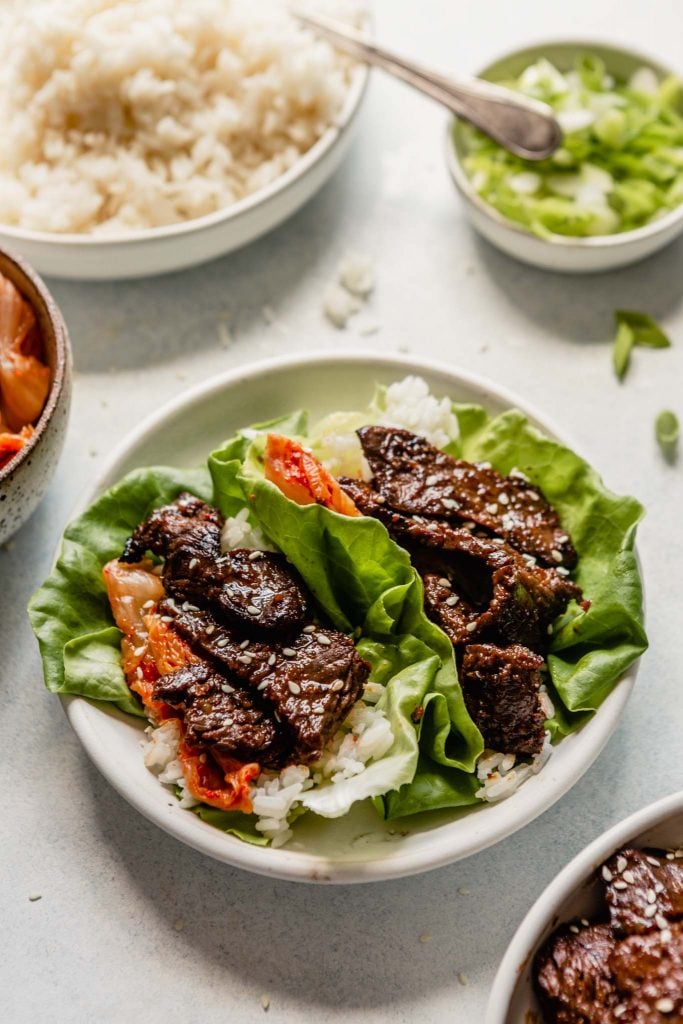
How to cook beef bulgogi
Beef bulgogi can be cooked on the stove top in a grill pan or cast-iron skillet, or it can be cooked on the grill. I prefer the grill because you get a more robust charring and caramelization. But again, you can certainly use a grill pan for the ease it.
You can buy pre-sliced meat at your local Korean grocery store or International market, or you can buy the cut of meat and slice it yourself. Either ways works!
If you plan to slice the meat yourself (I do), you may want to consider popping the meat in the freezer for about 30 minutes prior to slicing. This simple trick will make thinly slicing the meat much easier, especially if your knives aren’t very sharp.
Lastly, the most important thing to keep in mind when cooking bulgogi is to cook over high heat and to NOT overcrowd the pan or grill. The goal with cooking bulgogi is to get a nice caramelized char on the meat, not to steam it. So be sure your pan is pretty hot and be willing to cook the beef in a few batches to avoid crowding.
On the grill:
Prepare a charcoal or gas grill for high heat. Brush grill grate clean; brush grate with oil to coat. Working in batches if needed, making sure to not over crowd, arrange sliced beef on grate and grill just until beef is cooked through and browned, about 1½ minutes per side.
On the stove-top:
Heat a cast-iron grill pan or cast-iron skillet over medium-high for 5 minutes. Brush grates of pan with grapeseed oil and, working in batches, arrange beef in a single layer in pan. Cook beef until charred and just cooked through, 1½–2 minutes per side; transfer to a serving platter. Repeat cooking process with remaining beef.
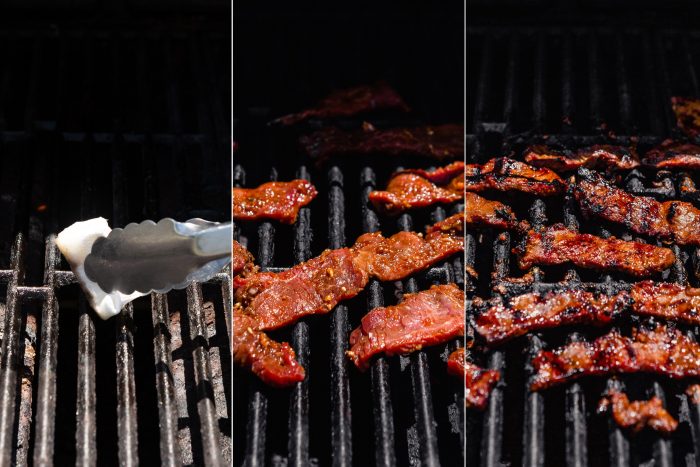
How to serve bulgogi
Traditionally, bulgogi is served in perilla leaves with gochujang or doenjang (soybean paste). I like to serve bulgogi in lettuce cups with cooked jasmine rice, kimchi, scallions and sesame seeds.
I’ll also cook down the leftover marinade (safe to eat once it’s brought to a boil and cooked for 1 minute) and drizzle that over top. If you’d prefer to skip the lettuce cups, simply serve the bulgogi over rice with the same toppings and some roasted broccoli.
What to serve beef bulgogi with
The nice thing about bulgogi, if you serve it with rice and lettuce cups, is that it can be a full meal. But if you’re looking for some other ways to use bulgogi, here are some ideas…
- Make a bulgogi veggie bowl by serving the meat over rice with thinly sliced cucumber, thinly sliced carrots, shredded cabbage, and bean sprouts.
- Serve over rice with sautéed mushrooms and sambal oelek.
- Serve over rice with some crispy fried garlic, serranos, and an over easy egg.
- Serve with quinoa and roasted broccoli.
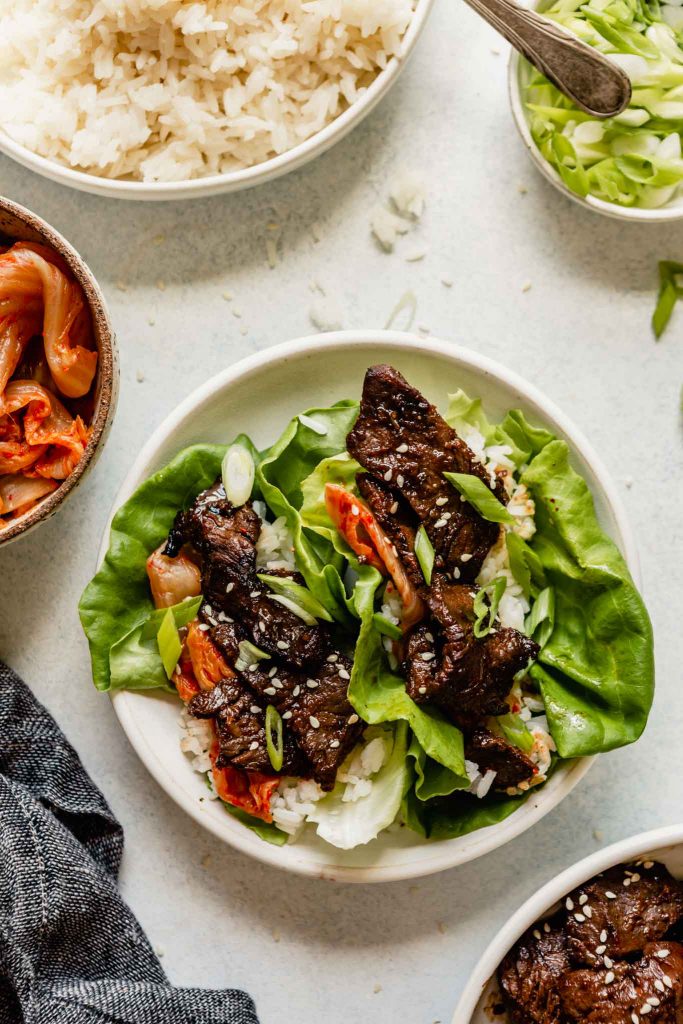
Side dishes that go with bulgogi
- Sautéed Cucumber Side Dish
- Cucumber Salad
- Green Onion Salad
- Bean Sprout Side Dish
- Quick rice noodle dish
- I also like to serve bulgogi with roasted broccoli!
More Korean-inspired recipes you may like…
Make sure to tag me @ZESTFULKITCHEN ON INSTAGRAM or tag #zestfulkitchen on social media if you make a recipe!
Don’t forget, if you make this bulgogi recipe, leave a comment and rating below!
To pin this recipe and save it for later, you can click the button on any of the photos, or the red button on the bar below the recipe. Happy cooking!
Beef Bulgogi
Description
Ingredients
Beef
- ¼ cup low-sodium soy sauce or tamari if gluten-free*
- ¼ cup grated white or yellow onion
- 3 tablespoons honey
- 1 tablespoon gochujang gluten free if needed
- 1 tablespoon minced garlic
- 1 tablespoon mirin or rice wine**
- 1 tablespoon toasted sesame oil
- 2 teaspoons grated fresh ginger
- ¼ teaspoon cracked black pepper
- 1 pound boneless rib-eye or top sirloin cut into ⅛–¼-inch thick slices
- 2 teaspoons grapeseed oil or other neutral oil
To serve:
- Cooked rice or quinoa
- Lettuce cups
- Kimchi
- Sliced green onions
- Sesame seeds
- Ssamjang
Instructions
- Whisk together soy sauce, onion, honey, gochujang, garlic, mirin, sesame oil, ginger and black pepper in a large bowl until combined. Add beef and toss to coat; cover and refrigerate for at least 2 hours, ideally 4 hours, or up to overnight.
Grill method
- Heat a grill to medium-high. Brush grill grate clean; brush grate with grapeseed oil to coat. Working in batches if needed, arrange sliced beef on grill grate and cook just until cooked through and browned, about 1½ minutes per side.
Stove-top method
- Heat a cast-iron grill pan (or cast-iron skillet) over medium high for 5 minutes. Brush grates of pan with grapeseed oil and, working in batches, arrange beef in a single layer in pan, making sure not to over crowd. Cook beef until charred and just cooked through, 1½–2 minutes per side; transfer to a serving platter. Repeat cooking process with remaining beef.
- Optional: reserve the marinade and transfer to a small saucepan. Bring mixture to a boil over medium-high heat; cook until slightly thickened, about 3 minutes. Serve sauce with bulgogi.
- Serve bulgogi with rice, butter lettuce cups, kimchi, scallions, sesame seeds, and ssamjang, if desired.
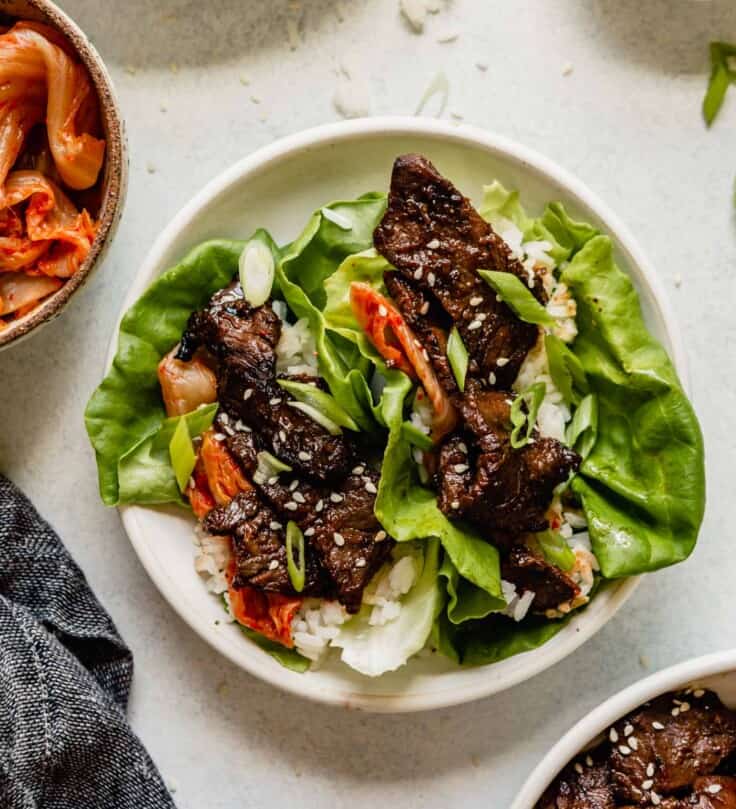
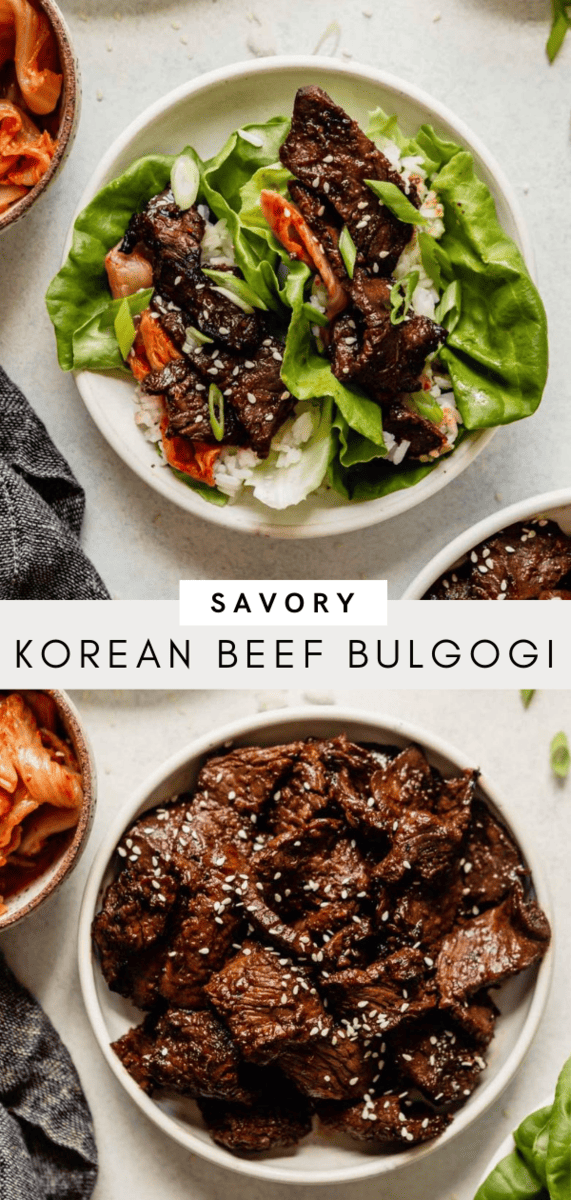
Made this last night and we LOVED it thank you! So flavorful!
Yay! It’s a favorite around here too! So glad you enjoyed it!
our new favorite! We don’t eat a lot of beef, but this is will be on regular rotation. Lost a few tiny pieces through the grill grate and it felt like losing gold! Will try this in a cast iron skillet next. so good.
Hi Carolyn! I am so happy to hear you enjoyed it!!